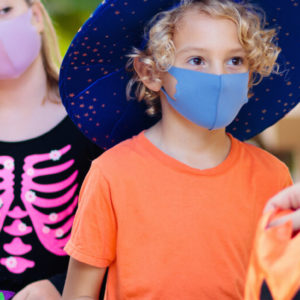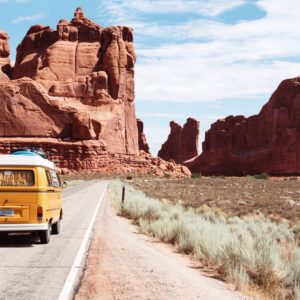Summer’s almost on its way out—and while many of us are focused on prepping for fall and getting ready for a different kind of back-to-school season, there are those of us who are still looking to squeeze in a last-minute summer vacation.
If you haven’t planned your trip yet, going to a national park is a great option for a socially distanced vacation. National parks allow you to experience nature, enjoy outdoor activities, and go on animal-watching adventures (with parks being forced to close for months, wildlife has been thriving) without having to deal with crowds of people.
But before you plan a visit, keep in mind that the pandemic has prompted some changes to how national parks operate and accept visitors. There are certain rules and regulations that need to be followed, and they may vary from park to park.

Find out everything you need to know about visiting national parks during COVID-19 with this helpful guide.
Are National Parks Open?
Yes. Most—if not all—national parks have reopened. After several months of being closed, national parks have begun to open their doors to hikers, campers, and local tourists. However, with the ongoing pandemic, parks are only able to operate at a limited capacity. And as a result, there are fewer trails and amenities open than usual.
Local restaurants, visitor center exhibits, and even lodges may have limited service hours, depending on which park you intend to visit.
As for transportation, shuttle bus services to some parks may have resumed, but this also depends on the park. If you plan on booking rental bikes and other recreational equipment, you may also need to reserve them several days ahead of time.
It’s also important to keep in mind that most parks are requiring online reservations made at least a month in advance—which means that spur-of-the-moment trips may be out of the question.
If you want to find out which parks are open and which services, amenities, and modes of transport are currently available within any specific park, you can visit the websites below:
- Recreation.gov– This is your one-stop-shop for all your trip needs. This website has detailed information on tickets, tours, available camping and lodging amenities, permits, and passes. This site also has tools and resources to help you plan your trip and the recreational activities. Gear rental information and lotteries for limited-entry permits can also be found on the site.
- United States Geological Survey (USGS) Store– If you want to learn more about National Parks and Recreational Lands annual passes or if you want to purchase one for yourself or your family, you can go to this website. Note that COVID-19 restrictions may affect annual pass processing and delivery, so make sure to get them in advance.
- National Park Service (NPS) Website– Get the latest updates, news, and active alerts from national parks across the country. Find an open national park near you with the site’s park locator tool. You can also get travel tips, ideas, and a list of upcoming events for different parks on this site.

National Park Visitors Guide During COVID-19
Planning a trip at this time may be a bit challenging as COVID-19 regulations are still in effect, even in national parks. In addition to the usual park rules and regulations, you’ll need to adhere to other safety regulations set by the Centers for Disease Control (CDC) and NPS.
To get you started, we’ve compiled some tips to help you plan a safe, enjoyable, and hassle-free trip.
Find the Best Time to Go
Aside from the fact that operations are limited due to the pandemic, national parks are not open for the entire year. Because of this, you’ll need to do a bit of research and find out which parks are open at this time.
Typically, summer is the peak season for most parks, so this is usually when they are most crowded. Meanwhile, there are some national parks you can visit early in the fall as well if you’re unable to get a reservation for the summer. The Great Smoky Mountains National Park in North Carolina and Tennessee or Yosemite National Park in California are a couple of stunning choices if you’re planning an autumn getaway.
As mentioned, summer is usually when national parks are most crowded, so planning a visit in the fall may be a better option. This way, you won’t have to interact with large crowds on the trails or on the campgrounds.

Decide: Day Trip or Camping?
Once you’ve settled on when to go and which park to visit, you should decide whether you want to go on a day trip or camp within the park grounds.
Camping allows you to experience the park for an extended period of time. This means you can be more flexible with your trip timetable and squeeze in more activities.
However, keep in mind that there are some rules you’ll have to observe when camping during the pandemic. People from the same household are encouraged to camp together and away from other groups. If you plan on camping with individuals who are not from the same household, make sure to pitch your tent at least six feet away from theirs.
Day trips are easier to plan since you’ll only be bringing food, water, and other gear for that trip only. You also won’t have to worry about camping permits and booking a slot at the campgrounds.
Guided tours and hikes are great activity options. If you plan on hiking, make sure to research the trails beforehand. Since some trails are closed, the ones that are open may be a bit crowded.
You can opt for an open but more challenging trail if you can handle it. However, it’s advised that challenging hikes be postponed during this time. This is because, in the event that you get into an accident, first responders and medical professionals may be diverted from the pandemic response.
If you plan on exploring the park in a vehicle, make sure to book the rental at least two days ahead.
Also, you’ll need to research active warnings and restrictions within the park. You can go to NPS.gov for more information.
Bring the Proper Gear & Essentials
Whether you’re planning on camping or going on a day trip, make sure to pack the right gear and essentials.
Pack extra drinking water, medicines, a first aid kit, and other safety gear that you may need, such as trekking poles and navigation devices.
Make sure to bring enough food as well, as there may be limited food and concession options inside the park. You should also bring your own eating and serving utensils.
Campers who bring RVs or trailers should also remember to pack their own vehicle repair tools and extra tires.
COVID-19 Essentials
Due to COVID-19, it is advised that you bring your own hand sanitizer, soap, personal hygiene products, and disinfectants so you can wash your hands and disinfect any surfaces and objects that may be contaminated.
The CDC and NPS also recommend bringing bandanas or cloth face coverings, especially if you’re planning on visiting areas of the park where you are more likely to come into contact with other visitors.
Book at Least a Month in Advance
As mentioned above, most national parks aren’t operating at full capacity to ensure proper social distancing within the grounds. This means that guests are encouraged to book their reservations in advance, preferably a month ahead.
You may be able to get an earlier reservation in the event of a cancellation, but to avoid any issues, make sure to get a reservation several weeks ahead of your visit.

Plan Your Itinerary
National parks are massive and can sometimes cover multiple states. You won’t have time to explore the entirety of the park in just a few days.
To maximize your visit, create a list of the attractions you want to see and the activities you want to do within the park.
If you’re planning on hiking, there are apps and websites where you can find out how long a specific trail will take for you to complete. This can help you plan a more thorough itinerary.
Recreation.gov is a great resource for learning more about the available activities and attractions at any given park. Make sure to check it out as you plan your itinerary to help you get the most out of your trip.
Inquire About Amenities & Lodges
If you plan on camping on park grounds, you will have to inquire about available spaces and amenities for campers, trailers, and tents, as slots may be limited.
Showers, dishwashing areas, and other common facilities may also not be available.
Meanwhile, historic lodges are great places to stay in, despite the heftier price tag. Consider making a reservation at a lodge for at least one night to experience the park in relative comfort.

Use Apps
If you’re not used to being in nature, exploring national parks can be a bit intimidating. Thankfully, there are several apps you can use to help you navigate your visit.
If you’re still in the planning phase of your trip, You can use the following apps and online resources to help you decide on certain aspects of your trip:
- NPS Official Website- As mentioned above, this website contains park information, updates, and active alerts. National parks sometimes issue site-specific alerts to inform visitors of closed trails, views, and entrances.
- Recreation.gov- This is your one-stop-shop for planning your trip. The site can give you information on where to purchase annual or site-specific passes. It also has several tools to help you apply for permits, sign up for tours, and other events.
- Gaia GPS– This app has a lot of features for hikers, campers, and adventurers. Find out more about the trails you want to take and access their maps and other navigating tools.
- Weather Channel– The weather channel app makes planning your trip easier. This app not only gives you weather information for the whole week, but it also gives you allergy and health risk alerts. The Weather Channel now also has a new hourly forecast feature, so definitely check it out.
Try a Guided Tour
If you’re uncomfortable exploring the park on your own, you can try going on a guided tour. These are great especially if you don’t want to deal with the stress of planning your trip. You can look at online brochures for tour companies online, or you can use some of the resources listed at Recreation.gov.
Going on guided tours also lets you learn about the park and see interesting sights that you wouldn’t have seen if you were to explore it on your own. There are a lot of tour companies that also let you experience the park in new ways such as hiking, biking, climbing, and other activities you might not have gear for.
Note that tours may not be available at some locations at this time, so make sure to do your research or contact the park you plan to visit or the tour company itself.
Opt for Smaller Parks or Less Crowded Trails
The CDC recommends going to smaller parks or parks with fewer visitors so you can avoid crowded trails and campgrounds. Interacting with groups of people who are not from the same household increases the risk of getting infected with COVID-19.
They also recommend visiting national parks in your home state or near your residence to avoid unnecessary long-distance travel.

While social distancing and mask-wearing are encouraged even in larger parks, it’s pretty difficult to avoid people, especially during the peak season.
Always make sure to observe proper safety measures and the CDC and NPS guidelines to keep you and your family safe.
Get a Park Pass
A park pass allows you to visit more than 2,000 federal recreation sites, including national parks and wildlife refuges. The pass covers the entrance fees at national parks and wildlife refuges as well as the standard amenity fees for national forests and grasslands.
Park passes also allow you to visit lands managed by the Bureau of Land Management and the Bureau of Reclamation.
The pass also covers the day-use fees for a driver and all the passengers within a personal vehicle at per-vehicle areas, or up to four adults at sites that charge per person.
For summer 2020, some national parks have reinstated entrance fees so they can safely expand access and resume normal operations.
How much is a National Park Pass?
An annual interagency pass is sold for $80 on the USGS website. As mentioned above, the pass allows the owner and their accompanying passengers in a single, private, non-commercial vehicle to enter federally-operated sites across the country. The pass covers three accompanying adults aged 16 and up.
Entrance fees are not required for children 15 and under.
The pass is valid for one full year from the month of purchase until the last day of that month. They’re non-refundable, non-transferable, and cannot be replaced if lost or stolen.
Due to the pandemic, however, there may be delays in processing and delivering online orders. This is because the USGS online store is still working to return to full operations. Fulfilling online orders will take 15 business days, while deliveries may take anywhere from two days to two weeks.
If you’re considering purchasing an interagency pass in person, consider your itinerary first. If you plan on visiting multiple sites, you can purchase your interagency pass at the first park you plan to visit. However, if you plan on visiting only one national park, you can avail of location-specific passes at the park itself.

Leave No Trace & Respect Wildlife
The most important rule of thumb when camping, hiking, or taking a trip to national parks and nature reserves is to leave no trace. Take your garbage with you. Make sure to acquaint yourself with the general park rules and follow them, especially those that concern proper garbage disposal and campfire set-ups.
Do not disturb the natural habitat of the park and always be respectful of the wildlife—keep your distance and refrain from touching the animals.
Talk to the Park Rangers
Park rangers possess a wealth of knowledge and information about the park, so it’s a good idea to strike up a conversation with any rangers you may come across during your stay. Talk to them if you have any concerns or questions about the area. They can also recommend sights to check out and activities to do in the park.
And of course, to ensure your safety and theirs, always remember to maintain a safe distance.
Follow CDC & NPS Guidelines
The CDC and NPS have provided guidelines for campers, hikers, and local tourists who plan on taking a trip to national parks and other natural attractions or destinations.
Listed below are a couple of reminders you need to keep in mind so you can enjoy a fun, safe, and worry-free vacation:
- Stay at least six feet away from other people who are not from the same household.
- Masks are encouraged but not required. You will need masks when social distancing is hard to follow (i.e., on crowded hiking trails and campgrounds).
- Masks should not be placed on children under the age of 2 or on anyone with breathing problems; also, avoid putting masks on someone who is unconscious, unable to move, or anyone who cannot remove the mask without assistance.
- Wash your hands often with soap and water. If you do not have easy access to soap and water, use hand sanitizers with at least 60% alcohol content.
- Do not share items and/or equipment with people you don’t live with.
- Stay home if you’re sick or tested positive for COVID-19. If you’ve been exposed to an infected individual in the last 14 days, you should also refrain from going on trips. Instead, stay in quarantine for a couple of weeks. You can contact your local hospital or go to the official CDC website for more information.

Most of us haven’t seen outside of the four walls of our homes—save for a few errands here and there—in months. Travel plans and vacations have been put on the backburner due to the COVID-19 restrictions and lockdowns, which means many of us are likely itching for an adventure.
Thankfully, national parks have reopened, and their big, open spaces offer safer vacation options as they allow us to give everyone else a wide berth.
Taking a trip to a national park should be a pretty safe experience, as long as you’re prepared. Keep yourself updated with the latest information about the park you’re going to visit and make sure to thoroughly plan everything to avoid any hiccups.
Again, do not leave any trace of your stay in these parks and forest reserves to show respect for nature and the wildlife around you. Most importantly, observe the official CDC and NPS guidelines for social distancing and hygiene to safeguard against COVID-19.
Stay safe and have a great trip!
Any information provided on this Website is for informational purposes only and is not intended to replace consultation with a professional mechanic. The accuracy and timeliness of the information may change from the time of publication.














